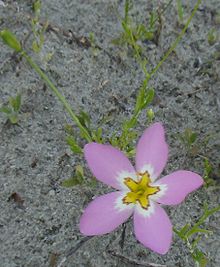- Sabatia stellaris
-
Sabatia stellaris 
Marsh Pink on Fripp Island Scientific classification Kingdom: Plantae (unranked): Angiosperms (unranked): Eudicots (unranked): Asterids Order: Gentianales Family: Gentianaceae Genus: Sabatia Species: S. stellaris Binomial name Sabatia stellaris
PurshSabatia stellaris (Rose of Plymouth, Marsh Pink, Salt-marsh Pink, Sea-pink; syn. Sabatia maculata (Benth.) Benth. & Hook.f., Sabatia palmeri Gray, Sabatia purpusii Brandeg., Sabatia simulata Britt.) is a species of Sabatia native to the eastern United States, where it occurs on the Atlantic and Gulf coasts, from Massachusetts south to Florida and west to Louisiana. It is listed as endangered in Massachusetts, Connecticut and New York.[1][2][3]
It is an annual plant growing to 20 cm tall in the northern part of its range, and up to 50 cm tall in the south of the range. The leaves are arranged in opposite pairs, narrow to broad elliptic in shape, with narrow leaves in Florida, and broad leaves in New England; the change in leaf shape is clinal, and cannot be separated into discrete subspecies or varieties.[2] The flowers are pink or white, with five or six corolla lobes ('petals'). The fruit is a dry capsule containing up to 600 seeds.[2]
It is restricted to salt marsh habitats, where it is threatened by the invasive species Phragmites australis.[2]
References
- ^ USDA Plants Profile: Sabatia stellaris
- ^ a b c d New England Plant Conservation Program: Sabatia stellaris Pursh (Sea pink) Conservation and Research Plan for New England (pdf file)
- ^ Connecticut Botanical Society: Sabatia stellaris
Categories:
Wikimedia Foundation. 2010.
